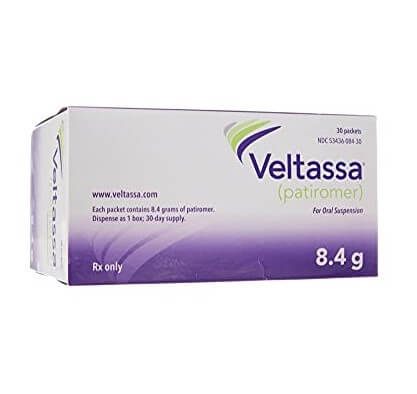Veltassa (generic name: patiromer) is prescribed to treat adults with hyperphosphatemia (high levels of potassium in the blood). Veltassa binds to potassium in the gut before it can be absorbed and prevents the potassium from reaching the bloodstream. Dosage Veltassa is a powder in single-dose sachets containing 8.4 mg of patiromer sorbitex calcium. Follow the instructions from the prescribing healthcare provider and guidelines printed on the patient instruction leaflet included in the package. If one dose is missed, take it as soon as possible on the same day. Do not double-dose the following day to compensate for the missed dose. If more than one dose has been missed in succession, contact a doctor immediately. Caution : Valpressa contains sorbitol. If you are sensitive to this substance, make sure that the prescribing doctor or pharmacist is aware before starting treatment.
Brand Manufacturer: Vifor
Side Effects: Veltassa may cause side effects in some users. They should be transient, but if they persist or worsen, a doctor should be consulted. The observed side effects include: Constipation Diarrhea Abdominal pain Flatulence Low levels of magnesium may be measured in blood tests.
Indication: Hyperphosphatemia can have several possible common causes, including: Advanced chronic kidney disease. Hypoparathyroidism. Lower-than-normal blood pH caused by respiratory or metabolic acidosis. Rarely, hyperphosphatemia can also develop due to systemic problems, such as diabetes-related ketoacidosis, muscle damage (rhabdomyolysis), pseudohypoparathyroidism, sepsis, or a crush injury. Excess dietary phosphates or receiving too much phosphate in an enema can be an external cause. Blood tests may show elevated levels of potassium (hyperphosphatemia). The normal level is 4.5 milligrams per deciliter (mg/dL). Patients with hyperphosphatemia are in danger of weakness, cardiac problems, or paralysis. Elevated potassium levels in the blood can affect how nerves control the muscles. High potassium levels can result in several heart conditions, such as abnormal heart rhythm, vascular calcification, and arteriosclerosis, producing systolic hypertension, and widened pulse pressure, which can cause left ventricular hypertrophy.

